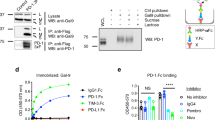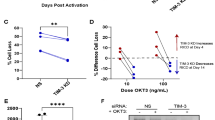Abstract
Fas Ligand (FasL) can induce apoptosis of Fas-bearing cells. It is expressed on the cell surface of many tumor cells, immune-privileged tissues and activated lymphocytes. We report here that FasL can itself transduce signals, leading to cell-cycle arrest and cell death in CD4+ T cells. In vitro, FasL engagement inhibited CD4+ T-cell proliferation, cell-cycle progression, and IL-2 secretion. In vivo, FasL engagement prevented superantigen-mediated CD4+, but not CD8+, T-cell expansion. These findings demonstrate that FasL engagement regulates cell-cycle progression, and show that FasL engagement in vivo has a potent anti-inflammatory effect specific for CD4+ T cells.
This is a preview of subscription content, access via your institution
Access options
Subscribe to this journal
Receive 12 print issues and online access
$209.00 per year
only $17.42 per issue
Buy this article
- Purchase on Springer Link
- Instant access to full article PDF
Prices may be subject to local taxes which are calculated during checkout







Similar content being viewed by others
References
Suda, T., Takahashi, T., Golstein, P. & Nagata, S. Molecular cloning and expression of the Fas ligand, a novel member of the tumor necrosis factor family. Cell 75, 1169–1178 (1993).
Suda, T. et al. Expression of the Fas ligand in cells of the T lineage. J. Immunol. 154, 3806–3813 (1995).
Hahne, M. et al. Activated B cells express functional Fas ligand. Eur. J. Immunol. 26, 721–724 (1996).
Saas, P. et al. Fas ligand expression by astrocytoma in vivo: maintaining immune privilege in the brain. J. Clin. Invest. 99, 1173–1178 (1997).
Arase, H., Arase, N. & Saito, T. Fas-mediated cytotoxicity by freshly isolated natural killer cells. J. Exp. Med. 181, 1235– 1238 (1995).
Ju, S.T. et al. Fas(CD95)/FasL interactions required for programmed cell death after T-cell activation. Nature 373, 345–348 (1995).
Dhein, J., Walczak, H., Baumler, C., Debatin, K.-M. & Krammer, P.H. Autocrine T-cell suicide mediated by APO-1/(Fas/CD95). Nature 373, 438–440 (1995).
Brunner, T. et al. Cell-autonomous Fas (CD95)/Fas-ligand interaction mediates activation-induced apoptosis in T-cell hybridomas. Nature 373, 342–345 (1995).
Renno, T., Hahne, M., Tschopp, J. & MacDonald, H.R. Peripheral T cells undergoing superantigen-induced apoptosis in vivo express B220 and upregulate Fas and Fas ligand. J. Exp. Med. 183, 431–437 (1996).
Kimura, M. & Matsuzawa, A. Autoimmunity in mice bearing lpr.cg: a novel mutant gene. Int. Rev. Immunol. 11, 193–210 (1994).
Hahne, M. et al. Characterization of the non-functional Fas ligand of gld mice. Int. Immunol. 7, 1381– 1386 (1995).
Chervonsky, A.V. et al. The role of Fas in autoimmune diabetes. Cell 89, 17–24 (1997).
Kondo, T., Suda, T., Fukuyama, H., Adachi, M. & Nagata, S. Essential role of the Fas ligand in the development of hepatitis. Nature Med. 3, 409– 413 (1997).
Giordano, C. et al. Potential Involvement of Fas and its ligand in the pathogenesis of Hashimoto's thyroiditis. Science 275, 960–963 (1997).
Itoh, N. et al. Requirement of Fas for the development of autoimmune diabetes in nonobese diabetic mice. J. Exp. Med. 186, 613–618 (1997).
Hahne, M. et al. Melanoma cell expression of Fas(Apo-a/CD95) Ligand: Implications for tumor immune escape. Science 274, 1363–1366 (1996).
O'Connell, J., O'Sullivan, G.C., Collins, J.K. & Shanahan, F. The Fas counterattack: Fas-mediated T cell killing by colon cancer cells expressing Fas ligand. J. Exp. Med. 184, 1075– 1082 (1996).
Niehans, G.A. et al. Human lung carcinomas express Fas ligand. Cancer Res. 57, 1007–1012 (1997).
Tanaka, M. et al. Fas ligand in human serum. Nature Med. 2, 317–322 (1996).
Seino, K., Kayagaki, N., Okumura, K. & Yagita, H. Anti-tumor effect of locally produced CD95L. Nature Med. 3, 165–170 (1997).
Arai, H., Chan, S.Y., Bishop, D.K. & Nabel, G.J. Inhibition of the alloantibody response by CD95 ligand. Nature Med. 3, 843–848 (1997).
Corry, D.B., Reiner, S.L., Linsley, P.S. & Locksley, R.M. Differential Effects of Blockade of CD28-B7 on the Development of Th1 or Th2 Effector Cells in Experimental Leishmaniasis. J. Immunol. 153, 4142–4148 (1994).
Kaneko, S., Suzuki, N., Koizumi, H., Yamamoto, S. & Sakane, T. Rescue by cytokines of apoptotic cell death induced by IL-2 deprivation of human antigen-specific T cell clones. Clin. Exp. Immunol. 109, 185–193 (1997).
Dou, Q.P., An, B., Antoku, K. & Johnson, D.E. Fas stimulation induces RB dephosphorylation and proteolysis that is blocked by inhibitors of the ICE protease family. J. Cell. Biochem. 64, 586–594 (1997).
Watanabe-Fukunaga, R., Brannan, C.I., Copeland, N.G., Jenkins, N.A. & Nagata, S. Lymphoproliferative disorder in mice explained by defects in Fas antigen that mediates apoptosis. Nature 356, 314–317 (1992).
Chu, J.L. et al. Massive upregulation of the Fas ligand in lpr and gld mice: implications for Fas regulation and the graft-versus-host disease-like wasting syndrome. J. Exp. Med. 181, 393– 398 (1995).
Herman, A., Kappler, J., Marrack, P. & Pullen, A.M. Superantigens: Mechanisms of T-Cell Stimulation and Role in Immune Responses. Ann. Rev. Immunol. 9, 745–772 (1991).
Jardetzky, T.S. et al. Three-dimensional structure of a human class II histocompatibility molecule complexed with superantigen. Nature 368, 711–718 (1994).
Krummel, M.F. & Allison, J.P. CTLA-4 Engagement Inhibits IL-2 Accumulation and Cell-cycle Progression upon Activation of Resting T cells. J. Exp. Med. 183, 2533– 2540 (1996).
Krummel, M.F. & Allison, J.P. CD28 and CTLA-4 have opposing effects on the response of T cells to stimulation. J. Exp. Med. 182, 459–463 (1995).
Walunas, T.L., Bakker, C.Y. & Bluestone, J.A. CTLA-4 Ligation Blocks CD28-dependent T Cell Activation. J. Exp. Med. 183, 2541– 2550 (1996).
Suzuki, I. & Fink, P.J. Maximal proliferation of cytotoxic T lymphocytes requires reverse signaling through Fas Ligand. J. Exp. Med. 187, 123–128 (1998).
Hutchings, P. et al. The regulation of autoimmunity through CD4+ T cells. Autoimmunity 15, 21–23 (1993).
Chandler, C. & Passaro, E., Jr. Transplant Rejection. Mechanisms and treatment. Arch. Surgery 128, 279– 283 (1993).
Prud'homme, G.J. & Vanier, L.E. Cyclosporine, tolerance, and autoimmunity. Clin. Immunol. Immunopathol. 66, 185–192 (1993).
Bellgrau, D. et al. A role for CD95 ligand in preventing graft rejection. Nature 377, 630–632 (1995).
Allison, J., Georgiou, H.M., Strasser, A. & Vaux, D.L. Transgenic expression of CD95 ligand on islet beta cells induces a granulocytic infiltration but does not confer immune privilege upon islet allografts. Proc. Natl. Acad. Sci. USA 94, 3943– 3947 (1997).
Seino, K., Kayagaki, N., Fukao, K., Okumura, K. & Yagita, H. Rejection of Fas ligand-expressing grafts. Transplant. Proc. 29, 1092–1093 (1997).
Kang, S.-M. et al. Fas ligand expression in islet of Langerhans does not confer immune privilege and instead targets them for rapid destruction. Nature Med. 3, 738–743 (1997).
Lau, H.T. & Stoeckert, C.J. FasL—Too much of a good thing? Nature Med. 3, 727– 728 (1997).
Gillis, S. & Smith, K.A. Long term culture of tumor-specific cytotoxic T cells. Nature 268, 154– 156 (1997).
Acknowledgements
We thank R. Budd and M. Coggeshall for their reviews of the manuscript,, J.E. Stone for technical assistance, C. Charland for flow cytometry, and R. Christie for secretarial assistance. Funding for these studies was provided by NIH ROI AI33470 (M.K.N), and USPHS-NIH AI40394 and AI40607 (R.C.D.). J.D. is supported by a Medical Research Council of Canada fellowship.
Author information
Authors and Affiliations
Corresponding author
Rights and permissions
About this article
Cite this article
Desbarats, J., Duke, R. & Newell, M. Newly discovered role for Fas ligand in the cell-cycle arrest of CD4+ T cells. Nat Med 4, 1377–1382 (1998). https://doi.org/10.1038/3965
Received:
Accepted:
Issue Date:
DOI: https://doi.org/10.1038/3965
This article is cited by
-
Fas ligand intracellular signaling: does PSTPIP mediate T cell death?
Apoptosis (2023)
-
The Autoimmune Lymphoproliferative Syndrome with Defective FAS or FAS-Ligand Functions
Journal of Clinical Immunology (2018)
-
Induction of apoptosis in breast cancer cells in vitro by Fas ligand reverse signaling
Journal of Cancer Research and Clinical Oncology (2018)
-
Mechanisms and Strategies for Tolerance in Liver Transplantation
Current Transplantation Reports (2016)
-
Targeting Apoptosis in Autoimmune Hepatitis
Digestive Diseases and Sciences (2014)



